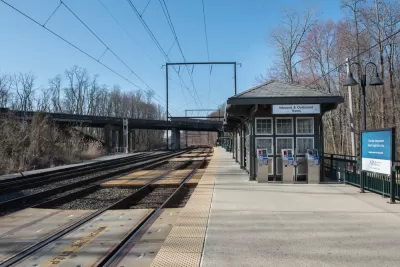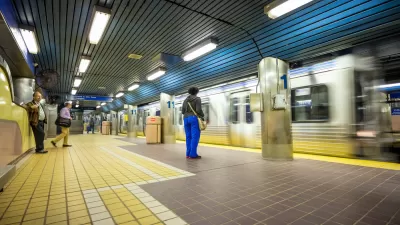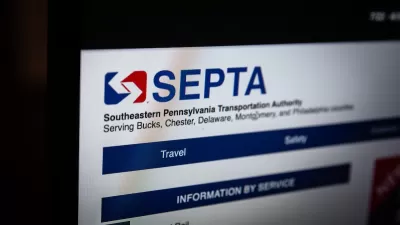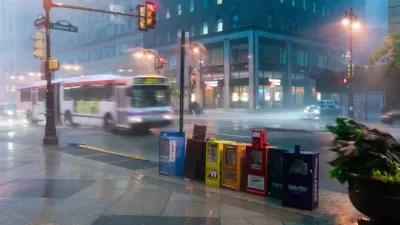Ridership on the nation's commuter rail services has plummeted more than other forms of transit during the pandemic. Serving a more affluent, professional ridership, commuter rail is looking more likely to face long-term cuts after the pandemic.

Patricia Madej writes about the uncertain future of commuter rail in light of the changing patterns of working and living during the pandemic, and the potential that some of these changes could be long lasting.
Madej summarizes the daunting challenges facing the Southeastern Pennsylvania Transportation Authority (SEPTA) in particular:
With ridership down about 85% from pre-pandemic levels, SEPTA Regional Rail is essentially running empty trains, and it’s clear that many of its suburban riders won’t return to five-day-a-week schedules given the appeal of white-collar telework. To sustain and grow Regional Rail ridership, transportation experts say, it should try to appeal to those it hasn’t in the past because of pricey fares and less frequent service. That was true before COVID-19 but may be more necessary now than ever, with the identity of Regional Rail turned on its head.
The article by Madej includes soundbites from several experts about how SEPTA might plan for more equitable service design in the post-panemic future. Megan Smirti Ryerson, associate dean for research at the University of Pennsylvania Stuart Weitzman School of Design, for example, says SEPTA should better integrate Regional Rail service with SEPTA bus, trolleys, and subway service.
“Now is the time to prioritize the needs of people of color, essential workers, and particularly our communities that have been significantly, economically hurt by the pandemic,” Ryerson said. “Transit is an opportunity to lift people up, to give them access to opportunities that they didn’t have before.”
This isn't the first time during the pandemic that commuter rail has faced scrutiny as potentially the most disposable mode of public transit given the declining transit ridership of the pandemic and the likelihood that working from home and migration to suburbs might have a long-term impact on ridership on commuter rail transit.
In November, for example, emergency service cuts at the Massachusetts Bay Transportation Authority (MBTA) cut commuter rail service in favor of bus service, in a move predicted at the time to be a feature of post-pandemic transit planning.
FULL STORY: Without commuters, what will happen to SEPTA Regional Rail?

Study: Maui’s Plan to Convert Vacation Rentals to Long-Term Housing Could Cause Nearly $1 Billion Economic Loss
The plan would reduce visitor accommodation by 25,% resulting in 1,900 jobs lost.

North Texas Transit Leaders Tout Benefits of TOD for Growing Region
At a summit focused on transit-oriented development, policymakers discussed how North Texas’ expanded light rail system can serve as a tool for economic growth.

Using Old Oil and Gas Wells for Green Energy Storage
Penn State researchers have found that repurposing abandoned oil and gas wells for geothermal-assisted compressed-air energy storage can boost efficiency, reduce environmental risks, and support clean energy and job transitions.

Private Donations Propel Early Restoration of Palisades Playground
Los Angeles has secured over $1.3 million in private funding to restore the Pacific Palisades playground months ahead of schedule, creating a modern, accessible space that supports community healing after recent wildfires.

From Blight to Benefit: Early Results From California’s Equitable Cleanup Program
The Equitable Community Revitalization Grant (ECRG) program is reshaping brownfield redevelopment by prioritizing projects in low-income and environmental justice communities, emphasizing equity, transparency, and community benefits.

Planting Relief: Tackling Las Vegas Heat One Tree at a Time
Nevada Plants, a Las Vegas-based nonprofit, is combating the city’s extreme urban heat by giving away trees to residents in underserved neighborhoods, promoting shade, sustainability, and community health.
Urban Design for Planners 1: Software Tools
This six-course series explores essential urban design concepts using open source software and equips planners with the tools they need to participate fully in the urban design process.
Planning for Universal Design
Learn the tools for implementing Universal Design in planning regulations.
Ascent Environmental
Borough of Carlisle
Institute for Housing and Urban Development Studies (IHS)
City of Grandview
Harvard GSD Executive Education
Toledo-Lucas County Plan Commissions
Salt Lake City
NYU Wagner Graduate School of Public Service





























